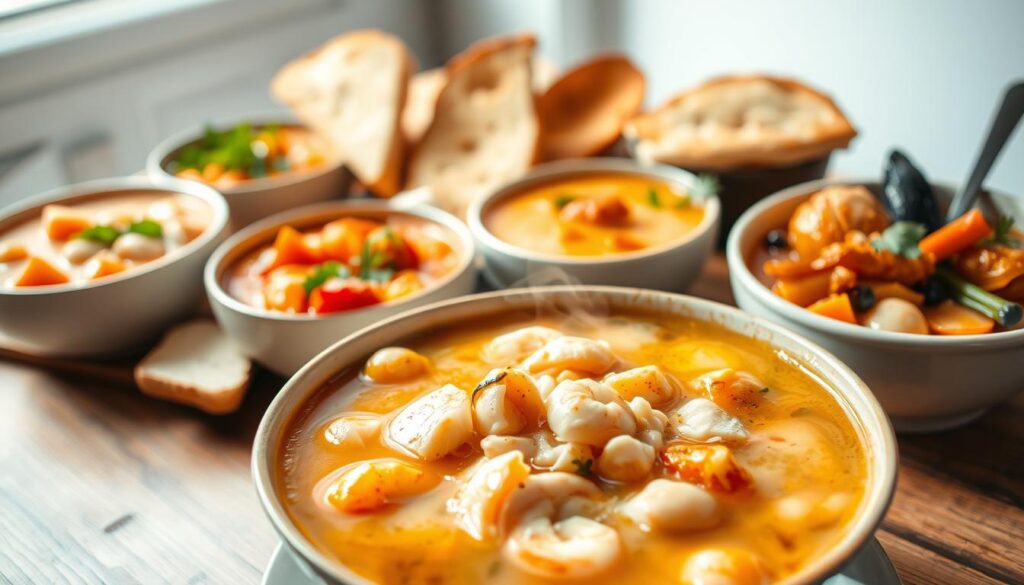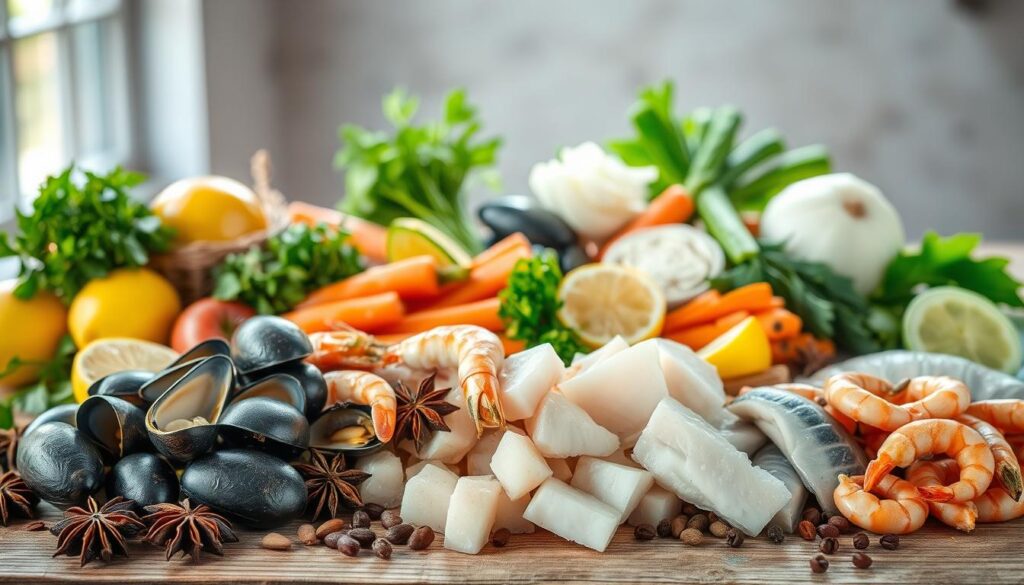The first time I tasted a rich, aromatic seafood soup, it was like discovering a hidden treasure of flavor. My grandmother’s kitchen would come alive with the sounds of simmering broth. The tantalizing aroma of fresh seafood filled the air, turning simple ingredients into a meal that felt like pure comfort.
Seafood soup recipes are more than just a dish—they’re a culinary adventure that brings warmth and excitement to your kitchen. Whether you’re craving a light fish stew or a hearty seafood chowder, these recipes offer something for every palate and occasion.
Ready to dive into the world of seafood soups? This guide will walk you through everything you need to know to create restaurant-quality dishes right in your own home. From selecting the freshest ingredients to mastering cooking techniques, you’ll become a seafood soup expert in no time.
Table of Contents
Understanding the Basics of Seafood Soup
Exploring seafood soups opens a world of flavors in your kitchen. You might want a classic clam chowder or try a rich seafood chowder. Knowing the basics is crucial for a dish that will be remembered.
To make the perfect seafood soup, you need to know about ingredients, techniques, and the right tools. Let’s look at the main things that will make you a seafood soup expert.
Types of Seafood Suitable for Soup
Your seafood chowder can have many ocean treasures. Some great choices are:
- Salmon (wild-caught preferred)
- Shrimp (jumbo, peeled and deveined)
- White fish (sea bass, halibut, cod)
- Mahi-mahi
- Mussels
- Optional additions: crab legs, scallops, clams
Essential Base Ingredients
A great seafood chowder starts with a solid base. Key ingredients are:
| Ingredient | Quantity | Purpose |
|---|---|---|
| Low-sodium chicken broth | 10 cups | Liquid base |
| No-salt-added tomato paste | 12 oz | Rich flavor |
| White onion | 1 medium | Aromatic base |
| Coconut milk/cream | Optional splash | Creamy texture |
Basic Cooking Equipment Needed
Get your kitchen ready with these essential tools for a perfect seafood soup:
- Large soup pot or Dutch oven
- Sharp chef’s knife
- Cutting board
- Wooden spoon
- Measuring cups and spoons
Pro tip: Fresh herbs like parsley can make your seafood chowder taste even better in the last few minutes of cooking.
The Perfect Seafood Soup Base: Building Flavors
Creating a delicious seafood soup starts with mastering the perfect base. Your shrimp bisque or lobster bisque will shine when you understand the art of layering flavors and selecting the right ingredients.
The foundation of an exceptional seafood soup begins with a high-quality stock. Choose a rich fish or seafood broth that captures the essence of the ocean. Professional chefs know that the base can make or break your soup.
- Select fresh aromatics like leeks, celery, and carrots
- Use white wine to add depth and complexity
- Incorporate umami-rich ingredients for intense flavor
When preparing a shrimp bisque, start by sautéing your vegetables in butter to release their natural sweetness. The key is to build layers of flavor gradually. Add tomatoes for acidity, herbs for freshness, and a splash of cream to create a luxurious texture in your lobster bisque.
“The secret to an amazing seafood soup is patience and understanding how flavors interact.” – Culinary Expert
Your base should complement the delicate flavors of seafood without overpowering them. Experiment with different techniques, and don’t be afraid to develop your unique twist on classic seafood soups.
Popular Seafood Soup Recipes

Explore the world of seafood soups that will warm your heart and excite your taste buds. Each recipe offers a unique flavor and cultural background. It’s a culinary journey through different regional traditions.
Classic Cioppino: An Italian-American Delight
Cioppino is a vibrant seafood stew from San Francisco’s Italian fishermen. It’s a hearty dish with fresh seafood in a rich tomato broth. It usually has:
- Fresh white fish
- Dungeness crab
- Shrimp
- Clams
- Mussels
Cioppino is great because you can change it up with different seafood. It’s a flexible dinner choice for seafood fans.
Creamy New England Style Chowder
New England clam chowder is a comfort food in a bowl. It has tender clams, potatoes, and a creamy broth. The secret to a great chowder is using fresh ingredients and letting flavors meld slowly.
Spicy Seafood Gumbo: Southern Comfort
Seafood gumbo brings Louisiana’s bold flavors to your kitchen. It’s a spicy soup with a dark roux base, seafood, and Creole ingredients. A true seafood gumbo includes:
- Andouille sausage
- Shrimp
- Crab meat
- Okra
- Celery
- Bell peppers
For authentic gumbo, be patient with the roux. Stir it constantly to get a deep, rich color.
Key Ingredients and Their Roles

Making the perfect crab soup or bouillabaisse starts with knowing the key ingredients. Each part is crucial for creating rich, complex flavors. These flavors will make your taste buds dance with joy.
The base of any seafood soup is top-notch seafood. Your soup can have various proteins for different tastes and textures:
- Salmon: Provides rich, buttery flavor
- Shrimp: Adds sweet, delicate notes
- Haddock or cod: Offers flaky, mild white fish essence
- Scallops: Brings a tender, luxurious element
Aromatics are the magic in making an amazing seafood soup. Fresh ingredients like garlic, onions, and celery make a strong flavor base. The right herbs can take your dish from good to great.
“The magic of a great seafood soup lies in the harmony of its ingredients” – Culinary Chef
Seafood soups are also great for your health. They have about 29g of protein per serving and important vitamins. This balance means every spoonful is full of flavor and good for you.
Choosing the right seasonings can turn a simple crab soup into a memorable dish. Try bay leaves, black pepper, and fresh parsley for depth and brightness.
Step-by-Step Cooking Techniques
Mastering seafood soup recipes needs precision and knowing cooking techniques. The right way can turn simple ingredients into a tasty meal.It will delight your taste buds and leave a lasting impression on your guests.
Creating the perfect seafood soup involves several key steps. These steps ensure the best flavor and texture. Let’s look at the essential techniques to make your seafood soup recipes stand out.
Preparing the Seafood
Your seafood soup’s success begins with proper seafood preparation. Follow these important steps:
- Clean seafood thoroughly under cold running water
- Remove shells and deveins shrimp completely
- Pat seafood dry with paper towels to ensure better searing
- Cut larger fish into uniform 2-ounce portions for even cooking
Creating the Broth
A rich, flavorful broth is the base of great seafood soup recipes. Begin by cooking onions, garlic, and celery in olive oil. Deglazing the pan with white wine adds deep, complex flavors.
Proper Cooking Times
Timing is key when cooking seafood to avoid overcooking and keep it tender. Here’s a quick guide:
- Squid: Cook for approximately 18 minutes
- Mussels and clams: 3 minutes until shells open
- Halibut: 2 minutes for perfect doneness
- Shrimp: Cook until just pink, around 1 minute
By following these techniques, you’ll make seafood soup recipes that are restaurant-quality in your own kitchen.
Tips for Selecting and Storing Seafood
Choosing the right seafood for your fish stew is key. Your senses are the best tools for this. Look for fish with firm, shiny flesh and a clean scent. Avoid any with a strong smell or discolored spots.
Here are key guidelines for selecting and storing seafood:
- Select wild-caught salmon for optimal flavor and quality
- Choose fresh medium shrimp, which comprise about 30% of the U.S. market
- Inspect seafood for bright, clear eyes and red gills
- Check for firm, elastic flesh that springs back when touched
Proper storage is crucial for seafood freshness. Your refrigerator should be set at 40°F or below to prevent bacterial growth. Store seafood in the coldest part of the fridge and use within 1-2 days. Freezing is an excellent choice for longer storage.
Freezing tips for your fish stew ingredients:
- Wrap seafood tightly in moisture-proof packaging
- Label with the date of freezing
- Freeze immediately after purchase
- Thaw seafood safely in the refrigerator or cold water
Safety is key when handling seafood. Pregnant women, children, and those with weak immune systems should be extra careful. Cook seafood to 145°F to avoid foodborne illness.
Pro tip: Fresh parsley added at the end of cooking can elevate the flavor of your fish stew!
Common Mistakes to Avoid When Making Seafood Soup
Making the perfect seafood chowder needs careful attention. Many home cooks unknowingly make mistakes that ruin their soup. These errors can turn a great dish into a bad one. Knowing these common mistakes can help you make your seafood soup amazing.
Temperature control is a big challenge for many. When making seafood chowder, keeping the right temperature is key. Boiling seafood can make it tough and rubbery. Instead, simmer it gently, especially when adding delicate seafood like salmon or medium shrimp.
Seasoning is another area where mistakes are common. Many cooks don’t season their soup enough, making it taste bland. To avoid this, layer your flavors. Start with fresh garlic, dried spices like oregano and basil, and finish with fresh parsley. Taste and adjust the seasoning often to get a rich flavor.
Timing is crucial when making seafood chowder. Adding ingredients at the wrong time can mess up the soup’s texture and taste. Add delicate seafood towards the end of cooking, usually 7 to 10 minutes before serving. This way, your fish will flake easily and your shrimp will be perfectly pink.
FAQ
What types of seafood work best in soups?
You can use firm white fish like cod or halibut in soups. Shellfish such as shrimp and clams also work well. Delicate fish like tilapia should be added last to keep them tender.
How can I prevent seafood from becoming tough in soup?
To keep seafood tender, add it towards the end of cooking. It usually takes 3-5 minutes to cook through. Use low heat and remove from heat once cooked.
What’s the best way to make a flavorful seafood soup base?
Start by sautéing onions, garlic, and celery. Then, deglaze with white wine. Use high-quality seafood stock as your base. Add herbs, lemon juice, and umami-rich ingredients like tomato paste for depth of flavor.
How do I choose fresh seafood for my soup?
Look for seafood with a fresh smell, not fishy or ammonia-like. Fish should have clear eyes and firm flesh. For shellfish, shells should be closed and smell fresh.
Can I make seafood soup ahead of time?
You can prepare the base and broth ahead. But add seafood just before serving. Store the base in the fridge for 1-2 days or freeze for a month. Reheat gently and add fresh seafood just before serving.
What are some common mistakes to avoid when making seafood soup?
Avoid boiling instead of simmering, which toughens seafood. Don’t add delicate seafood too early. Be careful with seasoning and use low heat.
How can I make my seafood soup more nutritious?
Add seafood rich in omega-3s and vegetables like kale or spinach. Use low-sodium stocks and aromatic vegetables. Consider adding whole grains or legumes for more protein and fiber.
Are there gluten-free options for seafood soup?
Yes! Most seafood soups can be made gluten-free. Use cornstarch or arrowroot for thickening and choose gluten-free stock. Many traditional recipes like cioppino and gumbo can be gluten-free with minor changes.

